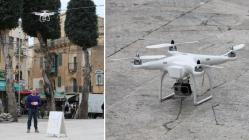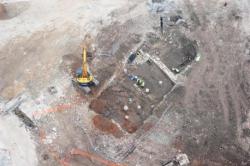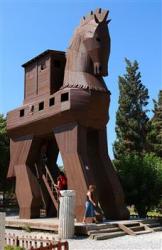INSTITUT SUPERIEUR D'ANTHROPOLOGIE
INSTITUTE OF ANTHROPOLOGY
ONLINE COURSES / COURS A DISTANCE
SPRING TERM : APRIL 2014
REGISTER NOW
MALTE –  Victoria - In the 1960s, during infrastructural works at Independence Square, Victoria, important archaeological remains were unearthed. The most important findings were three Roman oil lamps, a small marble torso and parts of wine amphorae. Following the discovery, an exploratory trench was dug and examined by archaeologist David Trump. The trench was dug to a depth of about three and a half metres and exposed a series of layers representing different cultures and phases of occupation. The trench extended for about 32 metres from beneath the Banca Giuratale to the base of the statue of Christ the King. It then proceeded up to the end of the square, turned at right angle and proceeded another 40 metres up to beneath St James church. Today, any archaeological remains lie buried under the road and paved surface. However, Victoria local council has tapped European funds to embark on a project that will lead to the mapping of these remains through the use of ground penetrating radar. Following the interpretation of the scans by archaeology experts, a manual will be produced on these remains. Mayor Samuel Azzopardi said that the project’s ultimate aim is to bring back to light the archaeological heritage that lies beneath Independence Square, and preserve it for future generations.
Victoria - In the 1960s, during infrastructural works at Independence Square, Victoria, important archaeological remains were unearthed. The most important findings were three Roman oil lamps, a small marble torso and parts of wine amphorae. Following the discovery, an exploratory trench was dug and examined by archaeologist David Trump. The trench was dug to a depth of about three and a half metres and exposed a series of layers representing different cultures and phases of occupation. The trench extended for about 32 metres from beneath the Banca Giuratale to the base of the statue of Christ the King. It then proceeded up to the end of the square, turned at right angle and proceeded another 40 metres up to beneath St James church. Today, any archaeological remains lie buried under the road and paved surface. However, Victoria local council has tapped European funds to embark on a project that will lead to the mapping of these remains through the use of ground penetrating radar. Following the interpretation of the scans by archaeology experts, a manual will be produced on these remains. Mayor Samuel Azzopardi said that the project’s ultimate aim is to bring back to light the archaeological heritage that lies beneath Independence Square, and preserve it for future generations.
http://www.timesofmalta.com/articles/view/20140316/gozo/Archaeological-remains-beneath-Independence-Square-being-scanned.510818
USA – Jeffersonville - Archaeologists digging next to the Kennedy Bridge in downtown Jeffersonville uncovered two portions of limestone foundations that date to the late 1700s or early 1800s, including one on a lot where former Indiana Territory Gov. Thomas Posey, who also was Kentucky's third lieutenant governor. once lived. But the archaeology project team re-buried the historical foundation portions under what will be part of the downtown crossing of the Ohio River Bridges Project.
ROYAUME UNI –  Newport - The remains of a medieval friary in Newport city centre are not significant enough to be preserved on site, an archaeological expert has said. With preparations for Friars Walk cracking on, a small team of archaeologists are hard at work uncovering part of the medieval history of Newport. There archaeologists have uncovered a wall and a stone floor from the old medieval friary – which had stood on the site as recently as the 19th century. http://www.southwalesargus.co.uk/news/11077106.Newport_Friary_remains___39_not_significant__39__says_expert/
Newport - The remains of a medieval friary in Newport city centre are not significant enough to be preserved on site, an archaeological expert has said. With preparations for Friars Walk cracking on, a small team of archaeologists are hard at work uncovering part of the medieval history of Newport. There archaeologists have uncovered a wall and a stone floor from the old medieval friary – which had stood on the site as recently as the 19th century. http://www.southwalesargus.co.uk/news/11077106.Newport_Friary_remains___39_not_significant__39__says_expert/
GRECE – Vergina - A Greek archaeologist says she has discovered 20 new burials near Macedonia's ancient capital in northern Greece, and some could tentatively be associated with the early Macedonian kings. Excavator Angeliki Kottaridi says two of the poorly preserved graves excavated in a cemetery between 2012-2013 "might perhaps be linked" with Alexander I and his son, Perdiccas II. Both reigned in the 5th century B.C., a century before the most famous ancient Macedonian king, Alexander III the Great. In a statement Thursday, Kottaridi said the graves at Vergina — believed to be ancient Aegae — were looted and largely dismantled in antiquity. Surviving finds included vases and a sword. A rich burial excavated decades ago at Vergina has been linked with Phillip II, father of Alexander the Great, although many experts disagree.
http://www.greenfieldreporter.com/view/story/08c78e8cd0e147d486112fb28d6fa81a/EU-Greece-Archaeology
TURQUIE –  Troie - New term excavations in the 5,000-year-old ancient city of Troy, which is located within the borders of the Tevfikiye village in the northwestern province of Çanakkale, will be carried out by a Turkish team for the first time. Under the auspices of Tübingen University, German archaeologists have so far worked in the ancient city with the sponsorship of German companies.
Troie - New term excavations in the 5,000-year-old ancient city of Troy, which is located within the borders of the Tevfikiye village in the northwestern province of Çanakkale, will be carried out by a Turkish team for the first time. Under the auspices of Tübingen University, German archaeologists have so far worked in the ancient city with the sponsorship of German companies.
http://www.hurriyetdailynews.com/a-new-term-starts-at-city-of-troy-with-turkish-team.aspx?pageID=238&nID=63540&NewsCatID=375
USA - Crescent Bar - A second set of human bones exposed by lowering the reservoir behind Wanapum Dam were found in the Crescent Bar area. Grant County sheriff's spokesman Kyle Foreman says the coroner believes the bones found last Friday are probably as old as the first bones found March 4. The wear pattern on the teeth indicates the person ate food different from modern humans. The bones were found by people exploring the shoreline after the reservoir was lowered because of a crack in the Wanapum Dam.
http://www.sfgate.com/news/article/2nd-set-of-human-bones-found-at-Crescent-Bar-5313700.php
PEROU –  Lambayeque - Archaeologists in Lambayeque will soon be able to use space age technology to aid them in their search for really old stuff. According to El Comercio, the Ministry of Culture in Lambayeque has acquired drones for use in archaeological surveys. El Comercio reports that each drone has six propellers that allow them to stay in the air. In addition, each drone has photo and video cameras to record information about the sites they scan. Archaeologists will use the drones to survey sites in order to determine their potential for excavation. But the sites won’t just be surveyed from above. El Comercio reports that culture authorities in Lambayeque have also obtainedGPS systems and georadar equipment. Georadar allows archaeologists to peek underground— up to 50 meters of depth— so they can see if there are any potentially valuable artifacts without having to break ground. “This will allow us to know a bit about the topography of the land so we can plan an excavation. It’ll reduce the planning times for archaeology projects,” explained José de la Cruz, a Mexican specialist in Perú to help train archaeologists.
Lambayeque - Archaeologists in Lambayeque will soon be able to use space age technology to aid them in their search for really old stuff. According to El Comercio, the Ministry of Culture in Lambayeque has acquired drones for use in archaeological surveys. El Comercio reports that each drone has six propellers that allow them to stay in the air. In addition, each drone has photo and video cameras to record information about the sites they scan. Archaeologists will use the drones to survey sites in order to determine their potential for excavation. But the sites won’t just be surveyed from above. El Comercio reports that culture authorities in Lambayeque have also obtainedGPS systems and georadar equipment. Georadar allows archaeologists to peek underground— up to 50 meters of depth— so they can see if there are any potentially valuable artifacts without having to break ground. “This will allow us to know a bit about the topography of the land so we can plan an excavation. It’ll reduce the planning times for archaeology projects,” explained José de la Cruz, a Mexican specialist in Perú to help train archaeologists.
http://www.peruthisweek.com/news-peru-lambayeque-receives-drones-for-surveying-archaeological-sites-102493